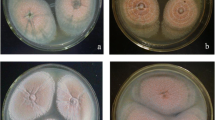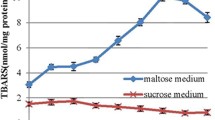Abstract
Growth and morphogenesis transformation in Polyporus umbellatus were examined in the presence of various pharmacological compounds, to investigate signal transduction pathways that influence the development of sclerotia. Both the calcium channel blocker nifedipine and the calcium ionophor A23187 reduced sclerotial production in P. umbellatus; four classes of Ca2+ signal agent—including calcium chelators, calcium channel blockers, calcium ionophors and calmodulin inhibitors—were further studied. Among them, EGTA and BAPTA, as calcium chelators, exhibited a complete inhibitory effect on sclerotial formation, among the levels tested. Calcium channel blockers and calcium ionophors at the concentrations used in this study could not eliminate sclerotia formation completely, but did greatly reduce sclerotial production. Notoginsenoside in dosages >250 μg/ml produced a significant negative effect on mycelial growth, and it prevented sclerotial formation entirely at a dosage of 500 μg/ml; no other drug influenced vegetative growth at all. The calcium ionophor A23187 did not decrease sclerotial mean weight at low doses (20 nM); at higher doses (200 nM), however, sclerotial development was significantly reduced, albeit not completely halted. The CaM inhibitors (W-7 and chlorpromazine) could each completely stop sclerotial formation. Using Fluo-3/AM as the indicator of cytosolic free calcium, the Ca2+ content in the cytoplasm was found to have decreased significantly when hyphae were treated with different drugs, and there was no active Ca2+ signal in the sclerotial mycelium. In general, the results suggest that Ca2+ signal transduction may play an important role in sclerotial formation in P. umbellatus.












Similar content being viewed by others
References
Xu JT. Chinese medicinal fungi. 1st ed. Beijing: Peking Union Medical College; 1997.
Miyazaki T, Oikawa N. Studies on fungal polysaccharide. VII. Water-soluble polysaccharide of Grifola (Fr.) Pilat. Chem Pharm Bull. 1973;21:2545–8.
Miyazaki T, Oikawa N, Yamada H, Yadomae T. Structural examination of antitumor, water-soluble glucans from Grifola umbellata by use of four type glucanase. Carbohydr Res. 1978;65:235–43.
Miyazaki T, Oikawa N, Yamada H, Yamada Y, Hsu H, et al. Relationship between the chemical structure and antitumor activity of glucans prepared from Grifola umbellate. Carbohydr Res. 1979;69:165–70.
Ueno Y, Okamoto Y, Yamauchi R, Kato K. An antitumor activity of the alkali-soluble polysaccharide (and its derivatives) obtained from the sclerotia of Grifola umbellata (Fr.) Pilat. Carbohydr Res. 1982;101:160–7.
You JS, Hau DM, Chen KT, Huang HF. Combined effects of Zhuling (Polyporus umbellatus) extract and mitomycin C on experimental liver cancer. Am J Chin Med. 1994;22:19–28.
Wang QY, Guo SY, Fan JY, Xue M. Characterization of Sclerotial Formation from Hyphae of Grifola umbellata. Acta Bot Sin. 2004;46:328–31.
Choi KD, Lee KT, Ban KW, Son SG, Shim JO, Lee SS, et al. The culture conditions of Grifola umbellata. J Anhui Agric Univ. 1999;26:292–9.
Guo SX, Xu JT. Nutrient source of sclerotia of Grifola umbellata and its relationship to Armillaria mellea. Acta Bot Sin. 1991;34:576–80.
Guo SX, Xu JT. Origin and development of crystal and thick-walled cells in sclerotia of Grifola umbellate. Acta Mycol Sin. 1992;11:49–54.
Guo SX, Xu JT. Genesis and function of defense structure of Grifola umbellata after Armillaria mellea infection. Acta Mycol Sin. 1993;12:283–8.
Bishop CD, Erezyilmaz DF, Flatt T, Georgiou CD, Hadfield MG, Heyland A, et al. What is metamorphosis. Integr Comp Biol. 2006;46:655–61.
Georgiou DC. Lipid peroxidation in Sclerotium rolfsii: a new look into the mechanism of sclerotial biogenesis in fungi. Mycol Res. 1997;101:460–4.
Abo Ellil AHA. Oxidative stress in relation to lipid peroxidation, sclerotial development and melanin production by sclerotium rolfsii. J Phytopathol. 1999;147:562–6.
Georgiou DC, Patsoukis N, Papapostolou I, Zervoudakis G. Sclerotial metamorphosis in filamentous fungi is induced by oxidative stress. Integr Comp Biol. 2006;46:691–712.
Chen DY, Lai HX, Lin YB. The investigation on mycelial growth and sclerotial formation of Polyporus umbellatus. Edible Fungi. 2004;6:8–9.
Gao S, Nuss DL. Distinct roles for two G protein a subunits in fungal virulence, morphology and reproduction revealed by targeted gene disruption. Proc Nat Acad Sci USA. 1996;93:14122–7.
Ruan Y, Kotraiah V, Straney DC. Flavonoids stimulate spore germination in Fusarium solani pathogenic on legumes in a manner sensitive to inhibitors of cAMP-dependent protein kinase. Mol Plant Microbe Interact. 1995;8:929–38.
Warwar V, Dickman MB. Effects of calcium and calmodulin on spore germination and appressorium development in Colletotrichum trifolii. Appl Environ Microbiol. 1996;62:74–9.
Hoch HC, Staples RC. Evidence that cAMP initiates nuclear division and infection structure formation in the bean rust fungus, Uromyces phaseoli. Exp Mycol. 1984;8:37–46.
Mitchell TK, Dean RA. The cAMP-dependent protein kinase catalytic subunit is required for appressorium formation and pathogenesis by the rice blast pathogen Magnaporthe grisea. Plant Cell. 1995;7:1869–78.
Xu JR, Hamer JE. MAP kinase and cAMP signaling regulate infection structure formation and pathogenic growth in the rice blast fungus Magnaporthe grisea. Gene Dev. 1996;10:2696–706.
Xu JR, Urban M, Sweigard JA, Hamer JE. The CPKA gene of Magnaporthe grisea is essential for appressorial penetration. Mol Plant Microbe Interact. 1997;10:187–94.
Yang Z, Dickman MB. Regulation of cAMP and cAMP dependent protein kinase during conidial germination and appressorium formation in Colletotrichum trifolii. Physiol Mol Plant Pathol. 1997;50:117–27.
Bolker M, Urban M, Kahmann R. The a mating type locus of U. maydis specifies cell signalling components. Cell. 1992;68:441–50.
Choi GH, Chen B, Nuss DL. Virus-mediated or transgenic suppression of a G-protein a subunit and attenuation of fungal virulence. Proc Nat Acad Sci USA. 1995;92:305–9.
Gao S, Duncan G, Barret K, Kronstad J. cAMP regulates morphogenesis in the fungal pathogen Ustilago maydis. Gene Dev. 1994;8:2805–16.
Regenfelder E, Spellig T, Hartmann A, Lauenstein S, Bolker M, Kahmann R. G proteins in Ustilago maydis: transmission of multiple signals? EMBO J. 1997;16:1934–42.
Robson GD, Wiebe MG, Trinci APJ. Exogenous cAMP and cGMP modulate branching in Fusarium graminearum. J Gen Microbiol. 1991;137:963–9.
Gadd GM. Signal transduction in fungi. In: Gow NAR, Gadd GM, editors. The growing fungus. London: Chapman & Hall; 1994. p. 183–210.
Sanders D, Pelloux J, Brownlee C, Harper JF. Calcium at the crossroads of signaling. Plant Cell. 2001;14:S401–17.
Berridge MJ, Bootman MD, Roderick HL. Calcium signalling: dynamics, homeostasis and remodelling. Nat Rev Mol Cell Biol. 2003;4:517–29.
Hyde GJ, Heath IB. Ca2+ gradients in hyphae and branches of Saprolegnia ferax. Fungal Genet Biol. 1997;21:238–51.
Kim Y, Li D, Kolattukudy PE. Induction of Ca2+-calmodulin signaling by hard-surface contact primes Colletotrichum gloeosporioides conidia to germinate and form appressoria. J Bacteriol. 1998;180:5144–50.
Chung K-R. Involvement of calcium/calmodulin signaling in cercosporin toxin biosynthesis by Cercospora nicotianae. Appl Environ Microbiol. 2003;69:1187–96.
Praveen Rao J, Subramanyam C. Requirement of Ca2+ for aflatoxin production: inhibitory effect of Ca2+ channel blockers of aflatoxin production by Aspergillus parasiticus NRRL 2999. Lett Appl Microbiol. 1999;28:85–8.
Spedding MS, Paoletti R. Classification of calcium channel and sites of drugs modifying channels function. Pharmacol Rev. 1992;44:363–5.
Liu JH, Ji FY, Wang T, Xie XD, Yao B. Effect of notoginsenosiole on Ca2+, excitory amino acid content in rat brain of cerebral ischemia and reperfusion. Chin J Clin Pharmacol Ther. 2002;7:33–4.
Yuan WY, Ye QF, Jiang WQ, Jiang WL, Shen RS. Elimination of oxygen free radicals in rat liver mitochondria by total saponins of panax notoginseng during ischemia reperfusion. Chin J Mod Med. 2005;20:3076–8.
Tester M. Plant ion channels: whole-cell and single-channel studies. New Phytol. 1990;114:305–40.
Bush SD. Calcium regulation in plant cells and its role in signaling. Annu Rev Plant Physiol Mol Biol. 1995;46:95–122.
Belyavskaya NA. Calcium and graviperception in plants inhibitor analysis. Int Rev Cytol. 1996;168:123–85.
Zhang WH, Rengel Z. Aluminium induces an increase in cytoplasmic calcium in intact wheat root apical cells. Aust J Plant Physiol. 1999;26:401–9.
Zhang WH, Rengel Z, Kuo J. Determination of intracellular Ca2+ in cells of intact wheat roots: loading of acetoxymethyl ester of Fluo-3 under low temperature. Plant J. 1998;15:147–51.
Acknowledgments
Financial supports from the key programme of the National Natural Science Foundation of China (No. 30830117).
Author information
Authors and Affiliations
Corresponding author
Rights and permissions
About this article
Cite this article
Liu, YY., Guo, SX. Involvement of Ca2+ Channel Signalling in Sclerotial Formation of Polyporus umbellatus . Mycopathologia 169, 139–150 (2010). https://doi.org/10.1007/s11046-009-9238-0
Received:
Accepted:
Published:
Issue Date:
DOI: https://doi.org/10.1007/s11046-009-9238-0




